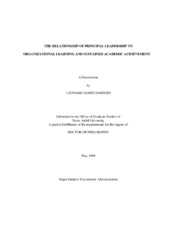| dc.contributor.advisor | Hoyle, John R. | |
| dc.creator | Hardoin, Leonard J. | |
| dc.date.accessioned | 2010-07-15T00:13:09Z | |
| dc.date.accessioned | 2010-07-23T21:44:31Z | |
| dc.date.available | 2010-07-15T00:13:09Z | |
| dc.date.available | 2010-07-23T21:44:31Z | |
| dc.date.created | 2009-05 | |
| dc.date.issued | 2010-07-14 | |
| dc.date.submitted | May 2009 | |
| dc.identifier.uri | https://hdl.handle.net/1969.1/ETD-TAMU-2009-05-621 | |
| dc.description.abstract | Some research suggests that development of professional learning communities
might be the organizational strategy that could make school reform more successful. While
most schools have not institutionalized the essential components of learning organizations,
studies have demonstrated that these attributes must be developed if professional staffs are
to realize the full benefit of organizational learning and in the process, create a context of
improvement.
The primary intent of this study was to learn and understand how principal
behaviors influenced the development of shared leadership, shared vision, and supportive
conditions; three essential dimensions of professional learning communities. Secondly, this
study investigated how these conditions differed among schools which have and have not
sustained high levels of student learning.
Understanding the influence of principal leadership on conditions for organizational
learning can be partially understood through either quantitative or qualitative methods.
From this perspective, the mixed methods design utilized in this study allowed both qualitative and quantitative data to be analyzed and interpreted as evidence in
understanding the study's problem.
Principal and teacher focus-group interviews were used to create a deeper
understanding of how principals worked to create conditions for organizational learning.
Kouzes and Posner's (2002) Leadership Practices Inventory - Self and Observer Forms
were utilized to identify, describe, and measure the perceived leadership practices of
principals.
The findings of this investigation suggest that principal leadership is a key factor in
creating conditions for organizational learning and sustaining high levels of student
achievement. Principals in this study who effectively identified and modeled espoused
values were perceived to be highly visionary and appeared more effective at sharing
leadership, inspiring vision, and creating supportive conditions. Principals who were able
to develop a shared vision among staff created strong collaborative cultures characterized
by an uncompromised focus on student learning. The findings of this study also indicated
that principals who effectively Model the Way, Inspire a Shared Vision, and Enable Others
to Act, distributed leadership among staff and demonstrated a systems orientation to
leading. | en |
| dc.format.mimetype | application/pdf | |
| dc.language.iso | eng | |
| dc.subject | Principal Leadership | en |
| dc.subject | Organizational Learning | en |
| dc.subject | Professional Learning Communities | en |
| dc.subject | Sustained Academic Achievement | en |
| dc.subject | Leadership Practices Inventory | en |
| dc.title | The Relationship of Principal Leadership to Organizational Learning and Sustained Academic Achievement | en |
| dc.type | Book | en |
| dc.type | Thesis | en |
| thesis.degree.department | Educational Administration and Human Resource Development | en |
| thesis.degree.discipline | Educational Administration | en |
| thesis.degree.grantor | Texas A&M University | en |
| thesis.degree.name | Doctor of Philosophy | en |
| thesis.degree.level | Doctoral | en |
| dc.contributor.committeeMember | Collier, Virginia | |
| dc.contributor.committeeMember | Zellner, Luana | |
| dc.contributor.committeeMember | Larke, Alvin | |
| dc.type.genre | Electronic Dissertation | en |
| dc.type.material | text | en |


